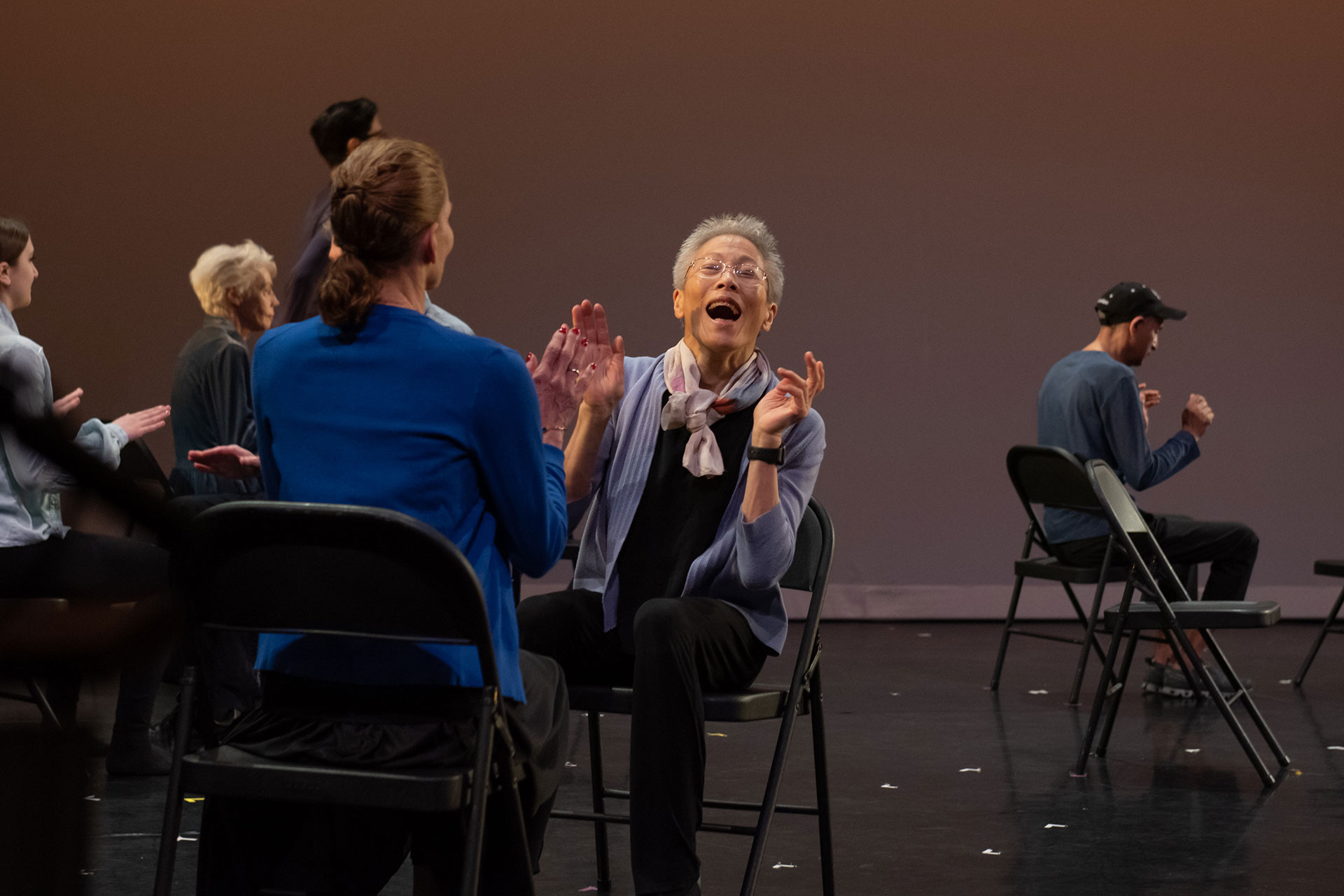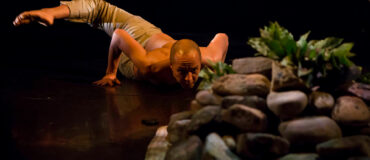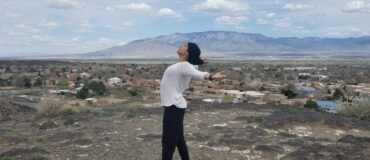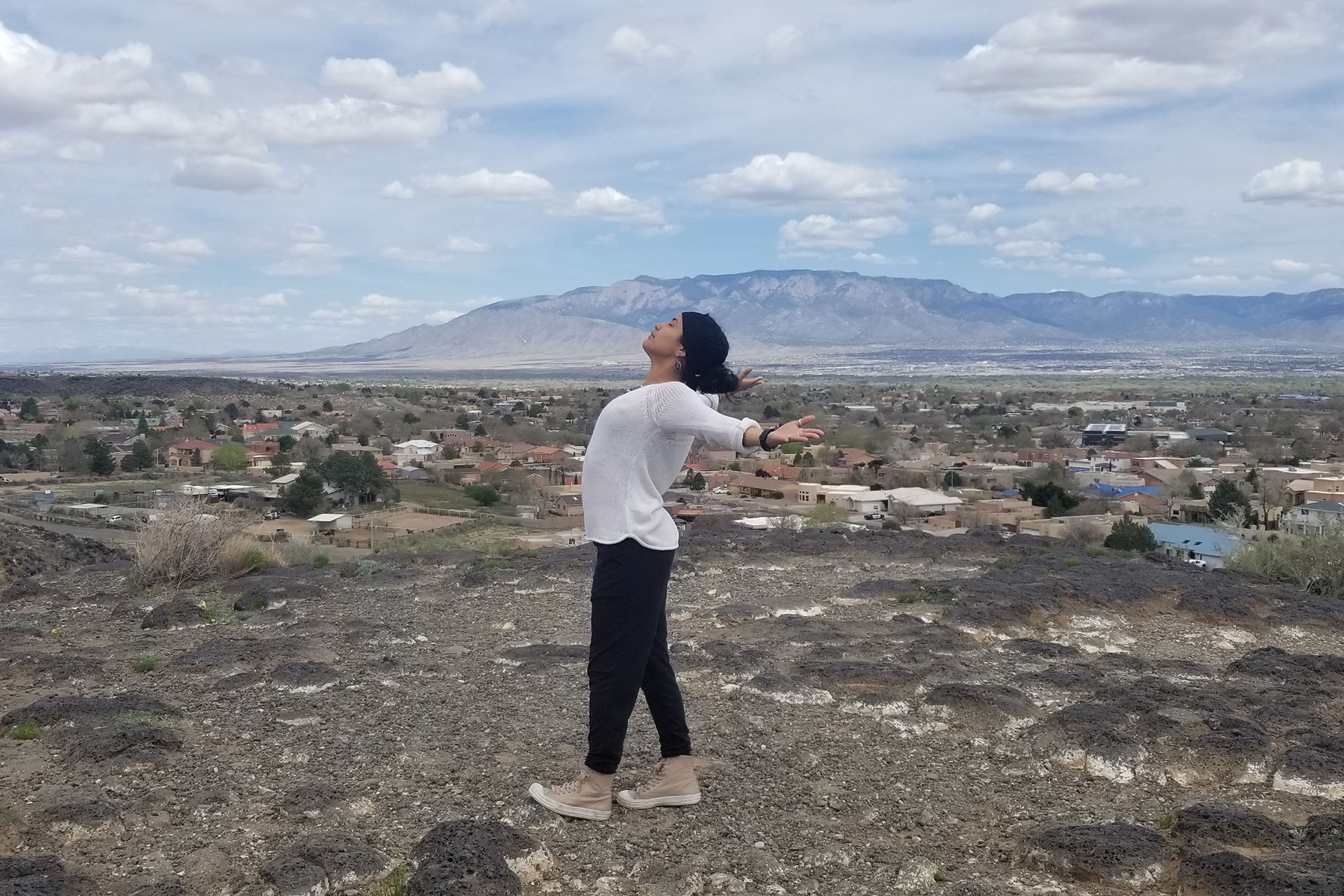Leading With Love: Navigating Tradition and Innovation
Prumsodun Ok, Patrick Makuakāne , and Sean Dorsey
By Toby MacNutt
Editor’s note: This article is one of 11 in a series examining the creative work of 31 dance artists funded by Dance/USA Fellowship to Artists, generously supported by the Doris Duke Charitable Foundation. These artists’ practices are embedded in social change as they work in multiple dance forms in communities across the country.

Patrick Makuakāne fosters a sense of kuleana, or shared, mutual responsibility, among dancers and the larger community. In 2018, his hālau — company — joined 80,000 others on the Playa at Burning Man. Makuakāne revealed the “heart capacity” he draws on to create for the community. Photo: Ron Worobec
In challenging the notion of who belongs, who is relatable and who can claim their place as a creative force in carrying the dance field forward, three dance artists — Prumsodun Ok, Patrick Makuakāne, and Sean Dorsey — execute, both on and off the stage, a brilliant balance of history and future.
These dancemakers amplify the notion of tradition-bearer in the evolving dance field. Ok embodies the study of Cambodian classical court dance; Makuakāne, the protocols of Hawaiian chant and dance; and Dorsey, the narratives of trans lives through the work of a contemporary dance company. But they also chart a departure into creative dancemaking that is possible because of the exquisite intersectionality of their rich identities. They create with great integrity, and deep hearts. I focus on love as a driving force of their expression, subverting a possible narrative of activism born only of suffering. As role models, these three serve as beacons of sanity for personal growth and the collective strength of their communities.
EVERYTHING COMES FROM LOVE

Raised in Long Beach, Calif., a son of Cambodian refugees, Prumdosun Ok created NATYARASA, Cambodia’s first gay dance company, to honor the past and shift opinions on LGBTQ people in Cambodia. He restages Khmer classical dances that were nearly extinguished during the genocide of 1975-79. Photo: Lim Sokchanlina
Prumsodun Ok is “passing on the love and knowledge given to [him] by [his] teacher, lighting an ancestral flame that has stayed burning for more than 1,000 years,” that of Khmer classical dance. His work is rich in color and texture, sensual, and full of myth and history — not only in its narratives and movement vocabulary, but in its emphasis on the cyclical nature of life and story.
In protest to what Ok calls the “legacy of violence,” when Khmer dance was nearly extinguished during the Khmer Rouge genocide of 1975 to 1979, Ok founded his company NATYARASA, the first of its kind formed only of gay Cambodian men. Growing up a gay child of refugees, Ok often found himself fearful in his search for his own truth — therefore he leads his company from a position of love and resilience. He “aspire[s] to live, teach, and create in a way where everything comes from love. Love as the highest expression of knowledge. Love that gives us strength to stand up for ourselves and those around us. Love that inspires us to move, and to move the world.”

Ornate and ethereal, Khmer classical dance was born of animist rites and evolved in the royal court, which enjoyed dance dramas featuring stories of gods and kings. Above, Ok instructs dancers Seourn Chamreoun (left) and Dy Puthik in specifics of placement. Photo: Morn Sopharoth
While love exists as a powerful force for performance, and the foundation on which communities are built, Ok recognizes that it is not itself enough. Dancers, like all people, deserve respect. He writes, “If I want to have dancers who live, create, and perform with pride, dignity, and independence, I need to give them the resources to live that way.” Dancers with his Phnom Penh-based company earn a living wage, and new doors, both literal and figurative, are opened to them, from international travel to being a source of pride for their families. His wholehearted commitment to pride, love, and dignity, supported by an intense amount of behind-the-scenes administrative work that he does on his own, elevates the significance of his company in its field. He has claimed his place in the Khmer tradition, proving that when those who were marginalized occupy such a place, they contribute to the growth and well-being of the artform and its whole community. Dancers, communities, and the form itself all are enriched and evolve.
DISCOVERING TRADITION AND INNOVATION
Patrick Makuakāne, kuma hula — master teacher — and director for his company Nā LeiHulu I Ka Wēkiu, dedicates himself to evolving traditional forms. As a result of the American occupation of Hawai’i, the traditions of hula were diminished and commodified for tourism. Makuakāne dove into the depth and breadth of traditional hula and is now exploring its future. He feels that “you can maintain and care for, evolve and innovate.”

Kumu hula — master teacher — Makuakāne grounds his dance in traditions passed down for generations. Yet he created a new hula form — hula mua or “hula that evolves” — which uses modern music and brings a new dimension to this ancient practice. Courtesy: P. Makuakāne
In California, he found the literal and figurative space for that innovation, experimenting with hula in some truly unusual settings – from airplanes to Burning Man, the annual temporary community dedicated to anti-consumerist creativity – using atypical music, costumes, or themes. He recognizes the ways that hula, with its innocuous reputation, is “a kind of dance that lets itself in the door” for those who view it. “And before you know it,” he said, “they’re learning something.” Audiences find themselves encountering a much deeper tradition than they may have expected, and Makuakāne does not shy away from exposing them to both the unpleasant history that built those expectations and the modern surprises that resonate with their own lives.
As with Ok’s work, the audiences are only one part of the picture of what nurtures the company. Makuakāne credits the strength of his community for sustaining Nā LeiHulu I Ka Wēkiu to its 35th anniversary in 2020. A lot of community care surrounds the company, from those who are born to it and raised in the traditions, rippling out through the company to its audiences. Among the company and community, a sense of kuleana, or shared, mutual responsibility to each other and the world, can be felt. This mutuality, love, and support create, as Makuakāne says, the “heart capacity” to keep growing the work and the community, by welcoming and evolving.
There is a thread of discovering who you are, finding your place, throughout Makuakāne’s work. His next show, Mahu, opens up that place in a new direction. The ancient word mahu referred to a person of a third gender, who possessed a specific spiritual or social role in the community. Today the title translates to a queerphobic slur, which is in the process of being reclaimed, and which Makuakāne, who is gay, recalled hearing in his youth. This work centers transgender or otherwise gender-variant Hawaiian hula artists, who have not worked together in a major production in which their gender identity is celebrated and serves as the focus of the performance. Makuakāne points to Kumu Hina, who focuses much of her energy on activism and nationhood: “She happens to be an exquisite dancer and chanter,” he says, adding, “I’m thrilled to highlight her exclusively as an artist.” Mahu promises an exciting fusion of skilled transgender Hawaiian artists performing traditional hula and the evolutions and experiments Makuakāne’s company has undertaken in San Francisco — all with a strong sense of heart and truth to self.
HOW TO BE A LIFE VEST FOR DANCERS

Sean Dorsey founded Fresh Meat Productions in 2002 to invest in the creative expression and cultural leadership of trans and gender-nonconforming individuals and communities. He uses performance to transform culture, heal trauma, build community, forge solidarity and create trans/gender, racial, disability, immigrant, economic and social justice. Photo: Lydia Daniller
Sean Dorsey’s choreography builds on truth-to-heart, melding storytelling with movement and orchestration in deeply emotional works. He focuses on queer identities, stories, histories, and relationships, especially transgender and queer masculine ones. While his “biggest motivator and passion as a dancemaker is to emotionally move, inter-connect, and in some way transform [his] audiences,” Dorsey’s effects, like Makuakāne’s, are not limited to the audiences who view his dances. He is relentless in pressing for equity in the dance field and uplifting other artists. He is especially a beacon — even a life vest — to trans dancers, seeking them out, promoting them, and role modeling for them. After an isolating, lonely entry to dance as a transgender young person, he is now out in the field making the next generation — or prior generations who thought they missed their shot — feel welcome. He writes, “If I can be part of changing the world so that trans and non-binary people see themselves, their bodies, their stories in modern dance — then I am blessed; I am so happy, all the isolation and struggle is worth it, a million times over.”
Dorsey dreams big for the dance field as a whole, and for transgender people, both professional dancers and otherwise. His vision includes “collectively lifting up and investing in leadership from BIPOC, QTPOC, disabled, trans and gender nonconforming, migrant, elder, Black trans women and femmes, fat and superfat, queer/LGBTQ+, trans and cis women, and youth communities.” As with Ok, he aims to not just be present making work in his field, and not just to nurture love in, for, and around his communities, but to foster respect, pride, and equity.

Dorsey (center) bills his Trans Supportive Modern Dance Class as perfect for “terrified beginners” and it’s “trans-friendly.” The classes are sensitive to transgender, trans, non-binary, and gender-nonconforming bodies and creative expressions, he said. Sean Dorsey Dance has offered these classes around the country. Courtesy: S. Dorsey
These dreams are the focus of Dorsey’s upcoming projects: the multi-year collaboration for The Lost Art of Dreaming, and its accompanying queer/trans workshop programming, “Dream Labs,” now taking place online and open to community members. The Lost Art of Dreaming imagines queer futures, pushing back against American ideals that deny the LGBTQ+ community the right to dream. The labs support surrounding communities in dancing, writing, crafting, and otherwise creatively imagining futures of their own.
All of these artists are finding — and making — their unique place in the universe of dance. They see next steps for their forms, their communities, and the field, and they take them. They balance their tough pasts with the promise of a better future; they challenge the notion of who can dance what; and they lead with love.
What would it look like if the “universal” appeal in dance was based on the full universe of its creators? What would dance look like if it was built on a foundation of love, and “pride, dignity, and independence”? As Ok asks, what would we create if we had the chance to “contemplate, focus, and act without the constant fear of how to survive”? What futures can we dream? How will we evolve?
In a moment when the future feels more fraught than ever before, we are fortunate to have these and other examples alongside us. The future is possible.
Let’s dream.
 m.jpg)
Toby MacNutt is a queer, nonbinary trans, disabled choreographer, dancer, poet, and teacher living in Vermont. Their work often explores questions of embodiment and selfhood, and features robust accessibility measures to welcome audience members with disabilities. Toby’s independent works include One, Two, an evening-length work on an integrated ensemble, 2014; Enter the Void, an immersive deep-space sci-fi dance and poetry installation, 2018; and the upcoming A Singular They, a solo ground and aerial show following the thread of change in their life. They have also danced with Murmurations Dance, Lida Winfield, Tiffany Rhynard, and Heidi Latsky’s GIMP. In 2018, Toby participated in the first ever AXIS Choreo-Lab, as one of seven disabled choreographers, prior to returning to work with the company in 2019. Find their work at www.tobymacnutt.com or on social media: Twitter @tobywm, Instagram @tobymacnutt.
Please visit the artists’ websites: Sean Dorsey, Patrick Makuakāne, and Prumsodun Ok. Readers may read and print a PDF version of this article here. Readers may visit and share this article on Medium here. Find more information on the DFA Article Series here and more information on Dance/USA Fellowships to artists here.
____
We accept submissions on topics relevant to the field: advocacy, artistic issues, arts policy, community building, development, employment, engagement, touring, and other topics that deal with the business of dance. We cannot publish criticism, single-company season announcements, and single-company or single artist profiles. Additionally, we welcome feedback on articles. If you have a topic that you would like to see addressed or feedback, please contact communications@danceusa.org.
Disclaimer: Opinions expressed in guest posts do not necessarily represent the viewpoints of Dance/USA.






